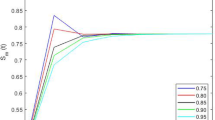Abstract
A theoretical model is proposed for a community which has the structure of two classes (direct and indirect) of commercial sex workers (CSW), and two classes of sexually active male customers with different levels of sexual activity. The direct CSW’s work in brothels while the indirect CSW’s are based in commercial establishments such as bars, cafes, and massage parlours where sex can be bought on request and conducted elsewhere. Behaviour change and the resulting change of activity class occurs between the two classes of CSW’s and two classes of males under the setting of the proliferation of human immunodeficiency virus (HIV)/acquired immunodeficiency syndrome epidemic and the subsequent intervention programmes. In recently years, this phenomenon has been observed in several countries in Asia. Given the lower levels of condom use and higher HIV prevalence of the indirect CSW’s, ascertaining the impact of this change in the structure of the sex industry on the spread of HIV is the main focus of this paper. The complete analysis of the disease-free model is given. For the full model, local analysis will be performed for the case of preferred mixing without activity class change, as well as the case with activity class change and restricted mixing. The basic reproduction number for the spread of epidemic will be derived for each case. Results of biological significance include: (i) the change of behaviour by the CSW’s has a more direct effect on the spread of HIV than that of the male customers; (ii) the basic reproduction number is obtained by considering all possible infection cycles of the heterosexual transmission of HIV which indicates the importance of understanding the sexual networking in heterosexual transmission of HIV; (iii) the social dynamics of the sex industry is not just a simple ’supply and demand’ mechanism driven by the demand of the customers, hence highlighting the need for further understanding of the changing structure of the sex industry. The main points of this work will be illustrated with numerical examples using the HIV data of Thailand.
Similar content being viewed by others
References
Anderson, R. M. and R. M. May (1992). Infectious Diseases of Humans: Dynamics and Control, Oxford: Oxford University Press.
Brown, T. and P. Xenos (1994). AIDS in Asia: the gathering storm. Asia-Pacific 16, Honolulu, East-West Center.
Bhassorn, L., C. Noppavan, T. Penporn and A. Wattana (1993). The Demographic and Behavioural Study of Female Commercial Sex Workers in Thailand, Bangkok: Institute of Population Studies, Chulalongkorn University.
Busenberg, S., K. Cooke and Y.-H. Hsieh (1995). A model for HIV in Asia. Math. Biosci. 128, 185–210.
Hsieh, Y.-H. (2002). The changing faces of commercial sex in Thailand: it’s implications for the spread of HIV/ADS. JAIDS 30, 537–540.
Hsieh, Y.-H. and K. Cooke (2000). Behaviour change and treatment of core group and bridge population: its effect on the spread of HIV/AIDS. IMA J. Math. Appl. Med. Biol. 17, 213–241.
Hyman, J. M. and J. Li (2000). An intuitive formulation for the reproductive number for the spread of diseases in heterogeneous populations. Math. Biosci. 167, 65–86.
Jacques, J. A., C. P. Simon, J. Koopman, L. Sattenspiel and T. Perry (1988). Modeling and analyzing HIV transmission: the effect of contact patterns. Math. Biosci. 92, 119–199.
Li, M. Y. and J. S. Muldowney (1995). Global stability for the SEIR model in epidemiology. Math. Biosci. 125, 155–164.
Mastro, T. D., G. A. Satten, T. Nopkesorn, S. Sangkharomya and I. M. Longini (1994). Probability of female-to-male transmission of HIV-1 in Thailand. Lancet 343, 204–207.
Morris, M., C. Podhisita, M. J. Wawer and M. S. Handcock (1996). Bridge populations in the spread of HIV/AIDS in Thailand. AIDS 10, 1265–1271.
Napaporn, H., J. Knodel and T. Bennet (1992). Sexual Networking in a Provincial Thai Setting, AIDS Prevention Monograph Series, vol. 1, Family Health International AIDSSCAP Project, Bangkok, Thailand: G. M. Press.
Sittitrai, W., P. Phanuphak, J. Barry and T. Brown (1992). Thai Sexual Behaviour and Risk of HIV Infection: A Report of the 1990 Survey of Partner Relations and Risk of HIV infection in Thailand, Program on AIDS, Bangkok, Thailand: Thai Red Cross Society, and Institute of Population Studies, Chulalongkorn University.
Thai Working Group on HIV/AIDS Projection (2001). Projection for HIV/AIDS in Thailand: 2000–2020, Bangkok, Thailand: Division of AIDS, Department of Communicable Diseases Control, MOPH.
van Griensven, G. J., B. Limanonda, N. Chongwatana, P. Tirasawat and R. A. Coutinho (1995). Socia-economic and demographic characteristics and HIV-1 infection among female commercial sex workers in Thailand. AIDS Care 7, 557–565.
Wathinee, B. and P. Guest (1994). Prostitution in Thailand, Salaya, Thailand: Institute for Population and Social Research, Mahidol University.
Weniger, B., K. Limpakarnjanarat, K. Ungchusak, S. Thanprasertsuk, K. Choopanya, S. Vanichseni, T. Uneklabh, P. Thongcharoen and C. Wasi (1991). The epidemiology of HIV infection and AIDS in Thailand. AIDS 5(Suppl. 2), S71–S85.
Author information
Authors and Affiliations
Corresponding author
Rights and permissions
About this article
Cite this article
Hsieh, YH., Chen, C.H. Modelling the social dynamics of a sex industry: Its implications for spread of HIV/AIDS. Bull. Math. Biol. 66, 143–166 (2004). https://doi.org/10.1016/j.bulm.2003.08.004
Received:
Accepted:
Issue Date:
DOI: https://doi.org/10.1016/j.bulm.2003.08.004




